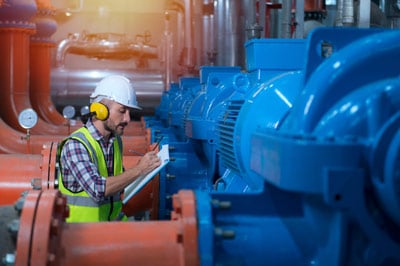Home » Blog » Wire to Water Efficiency: Why Is It Important?
Wire to Water Efficiency: Why Is It Important?

Efficiency is an essential factor that influences pump selection. Wire-to-water efficiency is often a critical parameter when selecting a pump, especially when the pump needs to operate in an industrial environment. In large-scale industrial applications, even a difference of 10% in efficiency can significantly impact overall operating costs in a year.
Let’s find out what wire to water efficiency means and how you can calculate this performance metric to ensure that your pump is functioning at optimum efficiency levels.
What is Wire-to-Water Efficiency?
 Wire-to-water efficiency measures how efficient a pump is in converting electricity for electro-mechanical work. In other words, it is a measure of how well the pump performs against the input electrical power that it receives.
Wire-to-water efficiency measures how efficient a pump is in converting electricity for electro-mechanical work. In other words, it is a measure of how well the pump performs against the input electrical power that it receives.
Wire to water efficiency helps you calculate the power required to pump water at a specific flow rate and pressure head. By varying the different parameters here, you can get the maximum efficiency setting from your pump.
While you can use wire-to-water efficiency charts that are already available for standard pump types, the type of pump system used also plays a critical role in getting the desired efficiency. Therefore, for larger pumps or a series of large pumps, fitting losses and the efficiency of variable speed drive combinations are also considered.
Mathematically,
Wire to water efficiency = (water horsepower/motor horsepower) x 100
In the case of variable speed motors, the denominator is the kilowatt energy supplied to the variable frequency drive instead of the motor.
The Importance of Wire-to-Water Efficiency
Wire to water efficiency is critical because the real-life performance of any pump will always differ from the theoretical values. Knowing the wire to water efficiency helps you set a pump to deliver desired flow rate and make the most out of the input electrical energy fed into the system.
A fluid pumping system consists of two major parts: a motor and a pump. A general belief is that the pump’s overall efficiency is the average of these two numbers. That means, if the pump efficiency is 85% and the motor efficiency is 90%, the average would be 87.5%. However, this calculation is incorrect. The actual efficiency is the product of both these numbers, which comes out to be 78%, and is much lesser than the presumed value.
For example, running a single pump at its maximum capacity results in a 20% efficiency loss compared to a system with two pumps maintaining the same flow. This is where a wire-to-water efficiency chart helps in determining the best system settings to maintain high-efficiency flow.
For industrial applications, the pump flow rate and input current will profoundly impact the operating costs. In such cases, it is possible to select and run pumps at the correct settings to get the best results with a wire-to-water efficiency chart.
How to Achieve Better Pump Efficiency?
Better pump efficiency translates to an efficient pump and less wastage of power, leading to less CO2 emission. However, achieving better efficiency does not always mean picking the most efficient motors and pumps and connecting them. As discussed earlier, it can even lead to poor performance.
For better efficiency, particularly in industrial applications, it is recommended to perform wire-to-water calculations that consider both the pump and motor parameters. With wire-to-water efficiency, you can design a system so that the pump curve intersects the system curve in the preferred operating region.
Get Assistance from Experts at Hayes Pump
Designing an efficient pump system can get overwhelming and complex if you ignore some of the key performance metrics that make an efficient pump system. At Hayes Pump, our highly skilled Field Sales Engineers can offer training and education for your personnel in pump and system operation, troubleshooting, equipment repair, reassembly, and more.




